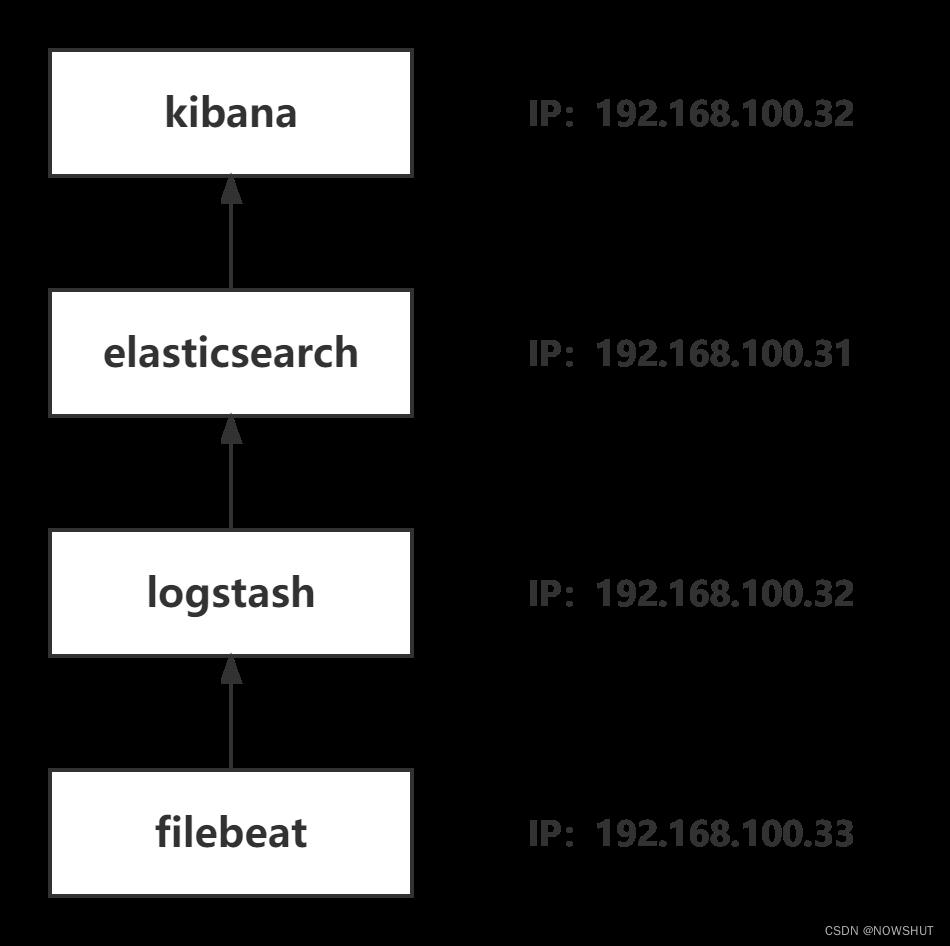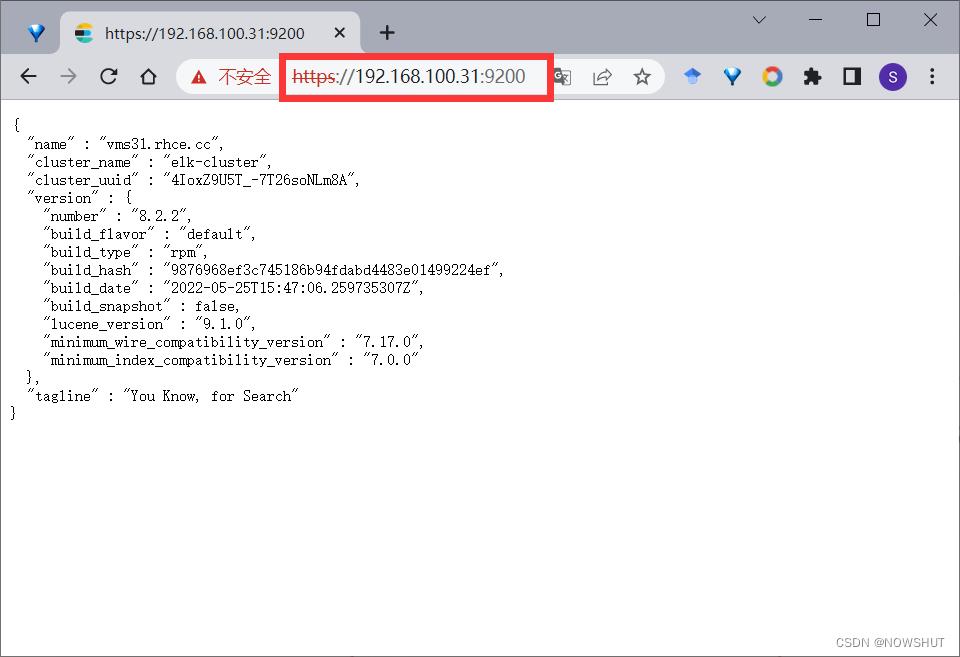Linux | ELK 8.2搭建ELKB集群Ⅰ—— 实验环境说明和搭建Elasticsearch集群
Posted NOWSHUT
tags:
篇首语:本文由小常识网(cha138.com)小编为大家整理,主要介绍了Linux | ELK 8.2搭建ELKB集群Ⅰ—— 实验环境说明和搭建Elasticsearch集群相关的知识,希望对你有一定的参考价值。
目录
1. 实验环境
1.1 实验工具
VMware® Workstation 16 Pro
1.2 操作系统
CentOS 7.9.2009 (Linux)
1.3 架构版本、IP地址规划与虚拟机配置要求
| 开源软件 | 虚拟机IP地址 | 版本 | CPU与内存 |
|---|---|---|---|
| Elasticsearch | 192.168.100.31,192.168.100.32 | 8.2.1 | 大于1cpu, 大于1G内存 |
| Logstash | 192.168.100.33 | 8.2.0 | 大于1cpu, 大于1G内存 |
| Kibana | 192.168.100.33 | 8.2.1 | 大于1cpu, 大于1G内存 |
| Filebeat | 192.168.100.31-33 | 8.2.1 | 大于1cpu, 大于1G内存 |
1.4 拓扑图

1.5 其他要求
- 所有虚拟机需要连接互联网,虚拟机网卡模式设置为NAT或桥接模式
2. 实验步骤
以下操作需要在三台虚拟机上同时进行
关闭防火墙
systemctl stop firewall
systemctl disabled firewall
将SELinux设置为disabled
vim /etc/selinux/config
SELINUX=disabled
同步服务器时间
yum install ntp #安装ntp服务
systemctl start ntpd #启动ntp
systemctl enable ntpd #设置开机自启
date #三台服务器的时间一致即可
2.1 安装Elasticsearch(单节点)
官方安装包下载地址:https://www.elastic.co/cn/downloads/elasticsearch
(1)检查系统jdk版本
rpm -qa | grep openjdk
java -version
如果系统没有java环境,需要自行安装。
yum install java
再次检查jdk环境

(2)下载elasticsearch
wget https://artifacts.elastic.co/downloads/elasticsearch/elasticsearch-8.2.2-x86_64.rpm
(3)安装elasticsearch
rpm -ivh elasticsearch-8.2.2-x86_64.rpm
警告:elasticsearch-8.2.2-x86_64.rpm: 头V4 RSA/SHA512 Signature, 密钥 ID d88e42b4: NOKEY
准备中... ################################# [100%]
正在升级/安装...
1:elasticsearch-0:8.2.2-1 ################################# [100%]
--------------------------- Security autoconfiguration information ------------------------------
Authentication and authorization are enabled.
TLS for the transport and HTTP layers is enabled and configured.
The generated password for the elastic built-in superuser is : GjKOXtfn5q1ZlHq7dM2K #内置超级用户密码
If this node should join an existing cluster, you can reconfigure this with #加入现有集群的命令
'/usr/share/elasticsearch/bin/elasticsearch-reconfigure-node --enrollment-token <token-here>'
after creating an enrollment token on your existing cluster.
You can complete the following actions at any time:
Reset the password of the elastic built-in superuser with #重置es内置超级用户的密码
'/usr/share/elasticsearch/bin/elasticsearch-reset-password -u elastic'.
Generate an enrollment token for Kibana instances with #为 Kibana 实例生成一个注册令牌
'/usr/share/elasticsearch/bin/elasticsearch-create-enrollment-token -s kibana'.
Generate an enrollment token for Elasticsearch nodes with #为 Elasticsearch 节点生成一个注册令牌
'/usr/share/elasticsearch/bin/elasticsearch-create-enrollment-token -s node'.
-------------------------------------------------------------------------------------------------
### NOT starting on installation, please execute the following statements to configure elasticsearch service to start automatically using systemd
sudo systemctl daemon-reload
sudo systemctl enable elasticsearch.service
### You can start elasticsearch service by executing
sudo systemctl start elasticsearch.service
使用rpm包安装的elasticsearch其配置目录在/etc/elasticsearch;安装目录在/usr/share/elasticsearch
小技巧:通过rpm -qc命令查看elasticsearch的配置文件路径
# rpm -qc elasticsearch-8.2.2-1.x86_64 /etc/elasticsearch/elasticsearch-plugins.example.yml /etc/elasticsearch/elasticsearch.yml /etc/elasticsearch/jvm.options /etc/elasticsearch/log4j2.properties /etc/elasticsearch/role_mapping.yml /etc/elasticsearch/roles.yml /etc/elasticsearch/users /etc/elasticsearch/users_roles /etc/sysconfig/elasticsearch /usr/lib/sysctl.d/elasticsearch.conf /usr/lib/systemd/system/elasticsearch.service
(4)配置elasticsearch
vim /etc/elasticsearch/elasticsearch.yml
# ======================== Elasticsearch Configuration =========================
#
# NOTE: Elasticsearch comes with reasonable defaults for most settings.
# Before you set out to tweak and tune the configuration, make sure you
# understand what are you trying to accomplish and the consequences.
#
# The primary way of configuring a node is via this file. This template lists
# the most important settings you may want to configure for a production cluster.
#
# Please consult the documentation for further information on configuration options:
# https://www.elastic.co/guide/en/elasticsearch/reference/index.html
#
# ---------------------------------- Cluster -----------------------------------
#
# Use a descriptive name for your cluster:
#
cluster.name: elk-cluster #自定义集群名
#
# ------------------------------------ Node ------------------------------------
#
# Use a descriptive name for the node:
#
#node.name: node-1 #自定义节点名
#
# Add custom attributes to the node:
#
#node.attr.rack: r1
#
# ----------------------------------- Paths ------------------------------------
#
# Path to directory where to store the data (separate multiple locations by comma):
#
path.data: /var/lib/elasticsearch #elasticsearch数据存放路径
#
# Path to log files:
#
path.logs: /var/log/elasticsearch #elasticsearch日志存放路径
#
# ----------------------------------- Memory -----------------------------------
#
# Lock the memory on startup:
#
#bootstrap.memory_lock: true
#
# Make sure that the heap size is set to about half the memory available
# on the system and that the owner of the process is allowed to use this
# limit.
#
# Elasticsearch performs poorly when the system is swapping the memory.
#
# ---------------------------------- Network -----------------------------------
#
# By default Elasticsearch is only accessible on localhost. Set a different
# address here to expose this node on the network:
#
network.host: 0.0.0.0 #设置能访问elasticsearch的IP地址,0.0.0.0表示所有IP都能访问,监听所有IP
#
# By default Elasticsearch listens for HTTP traffic on the first free port it
# finds starting at 9200. Set a specific HTTP port here:
#
http.port: 9200 #设置elasticsearch数据传输端口号,即监听端口,默认为9200
#
# For more information, consult the network module documentation.
#
# --------------------------------- Discovery ----------------------------------
#
# Pass an initial list of hosts to perform discovery when this node is started:
# The default list of hosts is ["127.0.0.1", "[::1]"]
#
#discovery.seed_hosts: ["host1", "host2"]
#
# Bootstrap the cluster using an initial set of master-eligible nodes:
#
#cluster.initial_master_nodes: ["node-1", "node-2"]
#
# For more information, consult the discovery and cluster formation module documentation.
#
# --------------------------------- Readiness ----------------------------------
#
# Enable an unauthenticated TCP readiness endpoint on localhost
#
#readiness.port: 9399
#
# ---------------------------------- Various -----------------------------------
#
# Allow wildcard deletion of indices:
#
#action.destructive_requires_name: false
#----------------------- BEGIN SECURITY AUTO CONFIGURATION -----------------------
#
# The following settings, TLS certificates, and keys have been automatically
# generated to configure Elasticsearch security features on 04-06-2022 20:18:05
#
# --------------------------------------------------------------------------------
# Enable security features
xpack.security.enabled: true #elasticsearch v7以后自动开启安全模式
xpack.security.enrollment.enabled: true
# Enable encryption for HTTP API client connections, such as Kibana, Logstash, and Agents
xpack.security.http.ssl:
enabled: true
keystore.path: certs/http.p12
# Enable encryption and mutual authentication between cluster nodes
xpack.security.transport.ssl:
enabled: true
verification_mode: certificate
keystore.path: certs/transport.p12
truststore.path: certs/transport.p12
# Create a new cluster with the current node only
# Additional nodes can still join the cluster later
cluster.initial_master_nodes: ["vms31.rhce.cc"]
# Allow HTTP API connections from anywhere
# Connections are encrypted and require user authentication
http.host: 0.0.0.0
# Allow other nodes to join the cluster from anywhere
# Connections are encrypted and mutually authenticated
#transport.host: 0.0.0.0
#----------------------- END SECURITY AUTO CONFIGURATION -------------------------
修改完后使用cat命令查看设置
# cat /etc/elasticsearch/elasticsearch.yml | grep -Ev "#|^$"
cluster.name: elk-cluster
path.data: /var/lib/elasticsearch
path.logs: /var/log/elasticsearch
network.host: 0.0.0.0
http.port: 9200
xpack.security.enabled: true
xpack.security.enrollment.enabled: true
xpack.security.http.ssl:
enabled: true
keystore.path: certs/http.p12
xpack.security.transport.ssl:
enabled: true
verification_mode: certificate
keystore.path: certs/transport.p12
truststore.path: certs/transport.p12
cluster.initial_master_nodes: ["vms31.rhce.cc"]
http.host: 0.0.0.0
(5)启动与查看服务
启动服务
systemctl start elasticsearch.service
systemctl enable elasticsearch.service
查看启动端口
# netstat -ntlup | grep java
tcp6 0 0 :::9200 :::* LISTEN 24625/java
tcp6 0 0 :::9300 :::* LISTEN 24625/java
其中9200是数据传输端口,9300示集群通信端口。
(6)访问elasticsearch
使用curl命令访问
# curl -u elastic:GjKOXtfn5q1ZlHq7dM2K https://192.168.100.31:9200/ --insecure
"name" : "vms31.rhce.cc",
"cluster_name" : "elk-cluster",
"cluster_uuid" : "4IoxZ9U5T_-7T26soNLm8A",
"version" :
"number" : "8.2.2",
"build_flavor" : "default",
"build_type" : "rpm",
"build_hash" : "9876968ef3c745186b94fdabd4483e01499224ef",
"build_date" : "2022-05-25T15:47:06.259735307Z",
"build_snapshot" : false,
"lucene_version" : "9.1.0",
"minimum_wire_compatibility_version" : "7.17.0",
"minimum_index_compatibility_version" : "7.0.0"
,
"tagline" : "You Know, for Search"
使用浏览器访问:https://192.168.100.31:9200/

2.2 搭建Elasticsearch集群
为了安装elasticsearch集群,我们将
- 192.168.100.31节点设置为master
- 192.168.100.32和192.168.100.33节点视为node
(1)安装elasticsearch
根据2.1的(1)——(3),在另外两台服务器192.168.100.32和192.168.100.33上安装elasticsearch
(2)配置elasticsearch集群
设置节点192.168.100.31
# cat /etc/elasticsearch/elasticsearch.yml | grep -v "#"
cluster.name: elk-cluster
node.name: node-1
path.data: /var/lib/elasticsearch
path.logs: /var/log/elasticsearch
network.host: 0.0.0.0
http.port: 9200
discovery.seed_hosts:
- 192.168.100.31:9300
- 192.168.100.32:9300
cluster.initial_master_nodes: ["node-1", "node-2"]
xpack.security.enabled: false
xpack.security.enrollment.enabled: true
xpack.security.http.ssl:
enabled: true
keystore.path: certs/http.p12
xpack.security.transport.ssl:
enabled: true
verification_mode: certificate
keystore.path: certs/transport.p12
truststore.path: certs/transport.p12
http.host: 0.0.0.0
设置节点192.168.100.32
# cat /etc/elasticsearch/elasticsearch.yml | grep -v "#"
cluster.name: elk-cluster
node.name: node-2
path.data: /var/lib/elasticsearch
path.logs: /var/log/elasticsearch
network.host: 0.0.0.0
http.port: 9200
discovery.seed_hosts: ["192.168.100.31:9300", "192.168.100.32:9300"]
cluster.initial_master_nodes: ["node-1", "node-2"]
xpack.security.enabled: false
xpack.security.enrollment.enabled: true
xpack.security.http.ssl:
enabled: true
keystore.path: certs/http.p12
xpack.security.transport.ssl:
enabled: true
verification_mode: certificate
keystore.path: certs/transport.p12
truststore.path: certs/transport.p12
http.host: 0.0.0.0
总结
初始化集群时,所有节点的
- 集群名cluster.name要一致,
- 集群IP地址discovery.seed_hosts要一致,
(3)重启elasticsearch服务
systemctl restart elasticsearch
(4)查看es集群信息
# curl http://192.168.100.31:9200/_cluster/health?pretty
"cluster_name" : "elk-cluster",
"status" : "green",
"timed_out" : false,
"number_of_nodes" : 2,
"number_of_data_nodes" : 2,
"active_primary_shards" : 2,
"active_shards" : 4,
"relocating_shards" : 0,
"initializing_shards" : 0,
"unassigned_shards" : 0,
"delayed_unassigned_shards" : 0,
"number_of_pending_tasks" : 0,
"number_of_in_flight_fetch" : 0,
"task_max_waiting_in_queue_millis" : 0,
"active_shards_percent_as_number" : 100.0
# curl http://192.168.100.31:9200/_nodes/process?pretty
"_nodes" :
"total" : 2,
"successful" : 2,
"failed" : 0
,
"cluster_name" : "elk-cluster",
"nodes" :
"8bB4P1EET2mjhecE4fez9Q" :
"name" : "node-2",
"transport_address" : "192.168.100.32:9300",
"host" : "192.168.100.32",
"ip" : "192.168.100.32",
"version" : "8.2.2",
"build_flavor" : "default",
"build_type" : "rpm",
"build_hash" : "9876968ef3c745186b94fdabd4483e01499224ef",
"roles" : [
"data",
"data_cold",
"data_content",
"data_frozen",
"data_hot",
"data_warm",
"ingest",
"master",
"ml",
"remote_cluster_client",
"transform"
],
"attributes" :
"ml.machine_memory" : "4122771456",
"ml.max_jvm_size" : "2063597568",
"xpack.installed" : "true"
,
"process" :
"refresh_interval_in_millis" : 1000,
"id" : 52915,
"mlockall" : false
,
"c69H-_ToSLOsbiiIZnY6QA" :
"name" : "node-1",
"transport_address" : "192.168.100.31:9300",
"host" : "192.168.100.31",
"ip" : "192.168.100.31",
"version" : "8.2.2",
"build_flavor" : "default",
"build_type" : "rpm",
"build_hash" : "9876968ef3c745186b94fdabd4483e01499224ef",
"roles" : [
"data",
"data_cold",
"data_content",
"data_frozen",
"data_hot",
"data_warm",
"ingest",
"master",
"ml",
"remote_cluster_client",
"transform"
],
"attributes" :
"xpack.installed" : "true",
"ml.max_jvm_size" : "2063597568",
"ml.machine_memory" : "4122771456"
,
"process" :
"refresh_interval_in_millis" : 1000,
"id" : 38585,
"mlockall" : false
参考资料
- Elasticsearch介绍:Elasticsearch 是什么?
- Elasticsearch文档:Elasticsearch Guide
- Logstash文档:Logstash Reference
- Kibana文档:Kibana Guide
- Filebeat文档:Filebeat Reference
关联博文
由于篇幅原因,关于搭建ELKB集群其他内容请查阅:
安装 Logstash 和 Kibana
安装 Filebeat和问题与解决方案
以上是关于Linux | ELK 8.2搭建ELKB集群Ⅰ—— 实验环境说明和搭建Elasticsearch集群的主要内容,如果未能解决你的问题,请参考以下文章